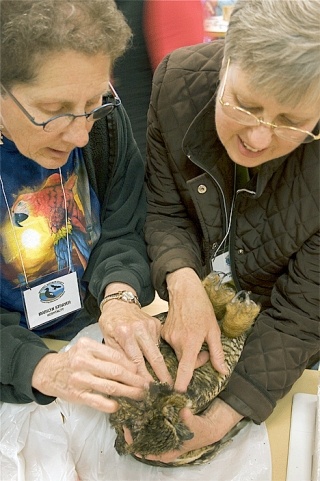At any other Audubon Society gathering, birders would need high-powered binoculars to get a good look at a bird, if they could zero in on their target before it takes flight.
This week, Matt Klope treated the society to an up close and personal viewing of hundreds of “expired” Whidbey Island birds.
“Matt Klope is very inspiring,” Robin Llewellyn said of his know-how of the frozen and taxidermy specimens, including corvids, seabirds, waders, ducks and other birds in the room.
Klope, a U.S. Navy wildlife biologist, countered that Llewellyn was the “brainchild” behind this event that is likely to become an annual event. Klope wasn’t sure exactly how many birds he brought, but estimated that his current collection represents about a quarter of the species that live on Whidbey Island.
In years to come, Klope hopes he’ll have more and more species to share with interested Audubon members.
“Four years from now, maybe we’ll have half the birds of Whidbey,” he said.
Throughout the year, Klope collects and catalogues the dead birds, mostly carcasses found by Audubon members, and shares a list of his inventory with Dr. Carla Dove of the Smithsonian Institute, which studies the birds’ molting patterns. Dr. Dove requests certain birds from the list and Klope sends them by overnight Fedex.
The remaining birds either go to the Burke Museum at the University of Washington, join Klope’s collection or receive a final burial.
“The whole idea of this is for the people to get up close and personal with the birds,” he said. “This is great. People are having debates about feather patterns.”
Audubon members weren’t shy with the thawing birds. Llewellyn gently pulled aside the large feathered tufts surrounding the great horned owl’s ear to get a better look at a part not often seen, and shared her view with fellow Audubon member Marilynn Strayer.
At another table, Pat Cozine demonstrated flight mechanics with taxedermied bird wings, flapping the specimens up and down, sparking a discussion of the differences of juvenile and adult birds.
Young birds are bigger, heavier and have longer feathers when they leave the nest, she said. These physical attributes give the fledglings a better chance at survival.
“Eighty percent of the birds hatched this year will not be around next year,” she said, explaining that the casualties are a result of birds flying into windows, being picked off by prey and starving.
In addition, feathered island residents are subject to gun shot, Llewellyn said of the importance of sharing such opportunities with the greater community.
“Education is an important part of these events, but right now we’re preaching to the choir.”


